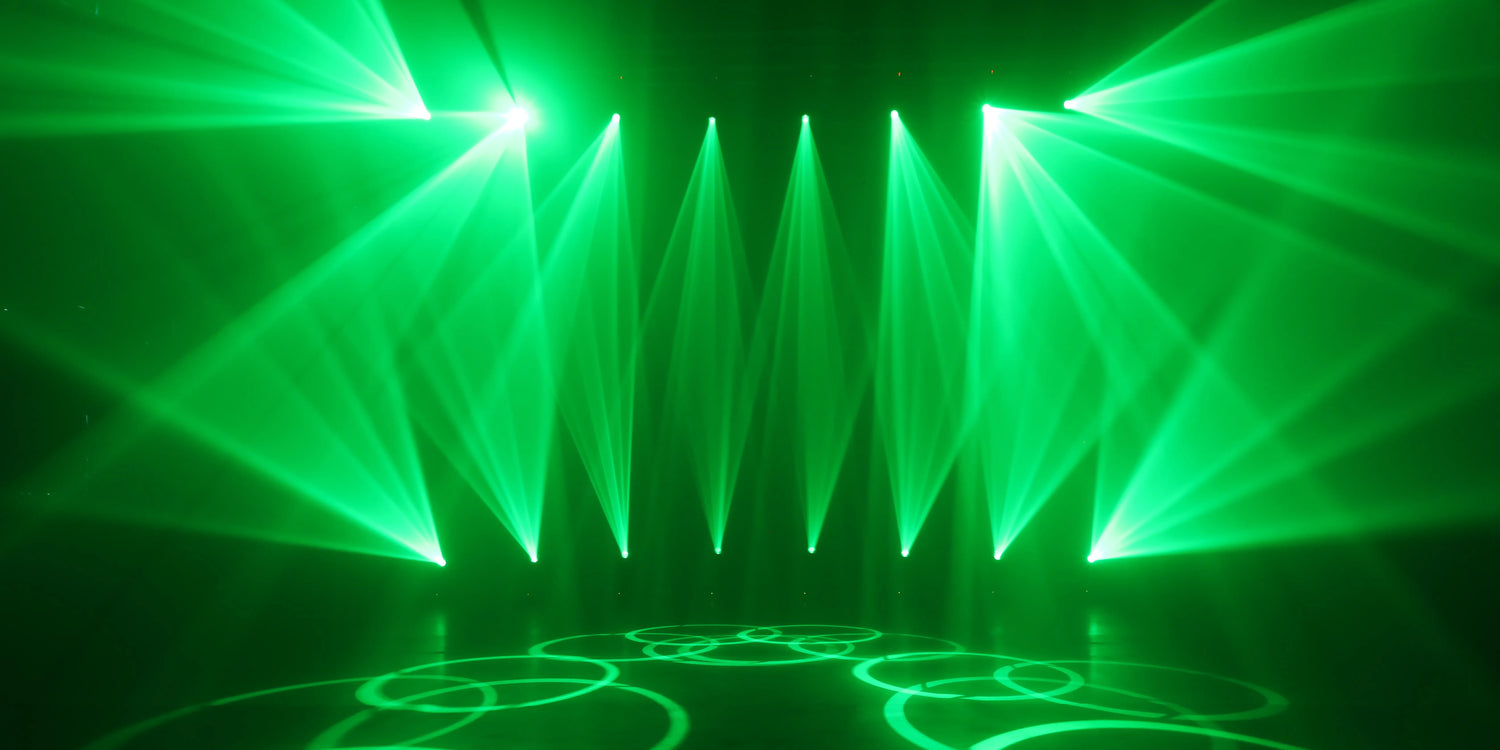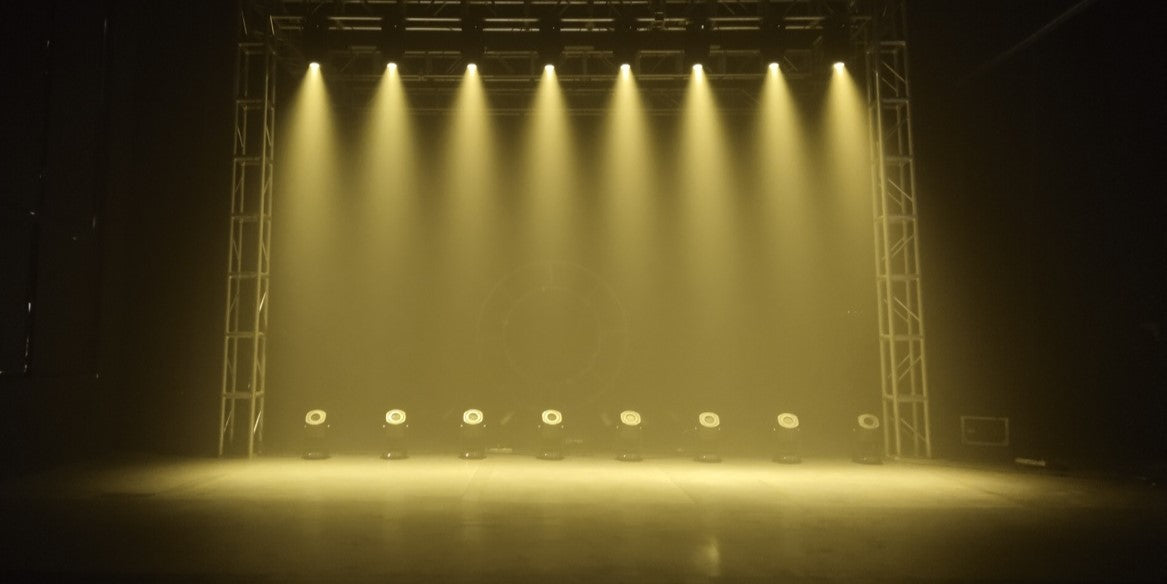The Art of Color in Stage Lighting
In the world of professional stage lighting, color is not just visual—it’s emotional. It defines the atmosphere of a concert, transforms the mood of a theatre, and adds warmth to weddings and live events.
While entry-level fixtures rely on fixed color wheels, high-end moving heads use an advanced system called CMY color mixing to achieve seamless, customizable color blending. This technology allows lighting designers to paint with light—creating smooth transitions, precise tones, and stunning visual harmony.

What Is CMY Color Mixing?
CMY stands for Cyan, Magenta, and Yellow, the subtractive primary colors used in high-end lighting systems and printing.
Unlike the RGB system, which adds colors by combining red, green, and blue light, CMY works by subtracting wavelengths from white light. When a fixture uses CMY filters:
- The cyan filter absorbs red wavelengths.
- The magenta filter absorbs green.
- The yellow filter absorbs blue.
By varying the density of each filter, lighting engineers can produce millions of unique hues with exceptional smoothness and accuracy—without relying on pre-set color wheels.
CMY vs. Color Wheel: Why CMY Wins
| Feature | CMY Color Mixing | Traditional Color Wheel |
|---|---|---|
| Color Range | Virtually infinite | Limited to fixed colors |
| Transition Smoothness | Seamless, fadeable | Step-based, mechanical |
| Control | Continuous and DMX-programmable | Manual or pre-set |
| Creative Flexibility | Full-spectrum creativity | Restricted combinations |
CMY mixing gives designers the freedom to fade from deep blue to golden amber with zero jumps or flicker. It’s essential for concert tours, broadcast lighting, and film production, where color consistency and fine control make all the difference.
How CMY Mixing Works Inside a Moving Head Light
Inside a professional moving head, you’ll find three motorized CMY filter plates—each corresponding to cyan, magenta, and yellow.
When light from the LED or discharge lamp passes through these gradient filters, the fixture subtracts specific wavelengths to create the desired color.
The motorized system allows ultra-fine control via DMX mapping, meaning designers can automate color fades, transitions, and effects in perfect sync with music or video cues.
Advanced models also include motorized focus and zoom, enabling dynamic beam shaping and precise light control across any distance.
Real-World Applications of CMY Mixing
CMY color mixing isn’t just technical—it’s transformative. Here’s how professionals use it across different industries:
- 🎤 Concerts & Tours — Create mood transitions that sync with musical energy.
- 🎭 Theatre & Drama — Match color tones to emotional scenes with accuracy.
- 💍 Wedding & Events — Blend soft romantic shades for ambience and photography.
- 🎬 Film & TV Lighting — Achieve flicker-free, camera-ready colors with consistent tone.
In every scenario, CMY ensures colors feel natural, balanced, and cinematic—making the entire stage come alive.
Betopper’s CMY Technology in Action
At Betopper, innovation meets precision.
Our Betopper BSW200 200w Spot Beam Wash Hybrid Moving Head Light has already launched, featuring motorized CMY color mixing with 2.5× zoom, prism effects, and focus control, allowing designers to transition seamlessly between wash, spot, and beam modes with effortless precision.
This level of creative control—once exclusive to large touring rigs—is now accessible in a compact, affordable, and professional fixture designed for modern DJs, event companies, and stage technicians.
How to Choose a CMY-Equipped Fixture
When shopping for a moving head light with CMY mixing, consider:
- Filter Quality – Look for optical-grade dichroic filters for consistent color density.
- Control System – Ensure it supports DMX512 or Art-Net for precise color mapping.
- Refresh Rate – High PWM frequency prevents flicker during video recording.
- Zoom Range & Optics – Adjustable zoom improves creative flexibility.
- Brand Reliability – Choose manufacturers with proven optical engineering (like Betopper).
CMY Mixing in Stage Lighting: FAQ
Q1: What’s the difference between RGB and CMY mixing?
→ RGB adds colors by combining light beams, while CMY subtracts wavelengths from white light. CMY produces smoother, more natural tones—ideal for professional use.
Q2: Do CMY lights need special controllers?
→ No. Any DMX-compatible controller can manage CMY fixtures through assigned channels.
Q3: Is CMY better for photography and video?
→ Absolutely. The smoother transitions and high refresh rates make CMY fixtures flicker-free and camera-friendly.
Conclusion: Painting the Stage with Light
CMY color mixing isn’t just a feature—it’s a game-changer for lighting professionals who care about precision, color depth, and creative control.
Whether you’re designing a live concert, setting up a wedding ambience, or producing a film, CMY technology gives you the power to shape light exactly the way you imagine it.
At Betopper, we bring this high-end technology into every fixture we build — combining performance, innovation, and reliability.
Our latest models like the BSW200 Hybrid Moving Head feature motorized CMY mixing, 2.5× zoom, and professional-grade optics, delivering smooth transitions and stunning color accuracy for every event.
💡 Ready to experience true color freedom?
Explore our full range of professional moving heads and stage lights with CMY color mixing on our official website: 👉 https://betopperdj.com
More control. More emotion. More color — that’s the power of Betopper.




Laisser un commentaire
Tous les commentaires sont modérés avant d'être publiés.
Ce site est protégé par hCaptcha, et la Politique de confidentialité et les Conditions de service de hCaptcha s’appliquent.